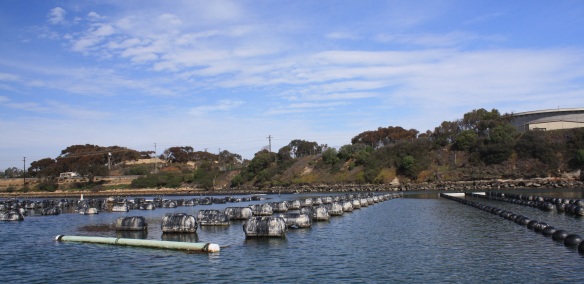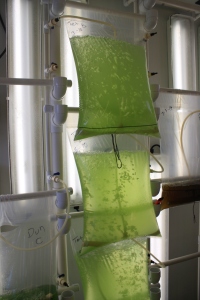
Lines of grey, barrel-shaped buoys (left) and black, spherical buoys (right) provide flotation for underwater support structures that house growing oysters and mussels at the Carlsbad Aquafarm in North San Diego County, CA
As a Californian, I had only heard snippets about ocean acidification (OA) before I started my Sea Grant Fellowship. Unlike the Mississippi River Delta, California isn’t infamous for large hypoxic “dead zones” created by agricultural nutrient run-off. And unlike Washington and Oregon, California isn’t known worldwide for its oyster hatcheries and shellfish farms, which have been heavily impacted by OA in the last several years. In fact, I didn’t know shellfish farms existed in Southern California until I visited the Carlsbad Aquafarm, which is located just north of San Diego.
Carlsbad Aquafarm is a low-key shellfish operation tucked into the same lagoon that houses the Carlsbad Nuclear Power Plant, right across the road from North San Diego County’s beautiful beaches. But the single-story sheds, and neat rows of unassuming black and grey buoys suspending underwater growth structures stretched across the lagoon, belie the fact that the farm sustains an impressive shellfish business, with nearly 1 million oysters alone currently growing in the water.

(left) Growing tanks house green abalone, one of the numerous shellfish species produced by Carlsbad Aquafarm. (right) A fully-grown green abalone (Haliotis fulgens)
Carlsbad Aquafarm, started in 1990, raises oysters, mussels, clams, abalone, scallops and seaweed to sell to Southern California farmer’s markets and wholesale seafood dealers, such as Santa Monica Seafood. Although several other shellfish aquafarms exist throughout California, including Hog Island Oyster Farm in Tomales Bay and the emerging Catalina Sea Ranch (which so far only grows mussels) off Huntington Beach, Carlsbad Aquafarm is currently Southern California’s only multi-species shellfish aquaculture farm.
One of my Fellowship mentor organizations, SCCOOS, is currently working with Professors Burke Hales (Oregon State University), and Todd Martz (Scripps Institution of Oceanography), to install a new partial/total CO2 (pCO2/TCO2) sensor at the Carlsbad Aquafarm. Monitoring the waters off Southern California will provide important ocean baseline comparisons for the low-pH, OA events that our northern neighbors are experiencing, as well as a general picture of how the southern part of the California Current Ecosystem is changing over time. It will also allow Carlsbad Aquafarm to track potential future OA events in its own waters, as the West Coast continues to be impacted by increasing global CO2 emissions and decreasing pH levels.
*
Ocean acidification events, and associated shellfish hatchery larvae die-offs, have been a growing problem in Washington and Oregon for the past several years. The British Columbia-based hatchery Island Scallops, which represents about 16 percent of British Columbia’s shellfish production, recently closed its processing plant and laid off a third of its workers because it couldn’t sustain production levels in the face of the deleterious effects that increasingly low-pH waters were having on its shellfish. Because of the immediacy and substantial, far-reaching economic impacts of OA events on these hatcheries, Oregon, Washington and southern British Columbia have implemented extensive systems of pH/pCO2 monitoring sensors to detect these events in real-time, in order to proactively protect shellfish stocks.

In addition to shellfish, the Carlsbad Aquafarm grows several species of algae to sell for fish food and human consumption.
So far, California, and especially Southern California, has experienced fewer noticeable low-pH events than have its northern neighbors. This is partly because Oregon and Washington have experienced stronger wind-driven upwelling of low-pH waters, and partly because California has a smaller-scale shellfish industry than do Oregon and Washington, so potential OA events haven’t been as urgent of a concern. And although Carlsbad Aquafarm has been unaffected overall by OA influences so far, the growers have noticed mussels sloughing off their byssal threads (the proteinaceous biomaterials that they produce to attach themselves to rocks, chains or other substrates) more during periodic lower-pH influxes, a phenomenon that has also been noted by recent research studies.
The West Coast is predicted to face continued decreases in ocean pH levels in coming decades. Models even estimate that by the year 2050, aragonite saturation levels will be permanently below those that can sustain healthy shellfish growth. So California must be as prepared as the rest of the west coast, and begin monitoring now in order to mitigate and avoid harmful effects in the future.
Thank you to Dennis Peterson, head aquaculturist at the Carlsbad Aquafarm, for a fascinating and informative tour!
